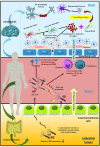Dysbiosis of Gut Microbiota from the Perspective of the Gut-Brain Axis: Role in the Provocation of Neurological Disorders
- PMID: 36355147
- PMCID: PMC9692419
- DOI: 10.3390/metabo12111064
Dysbiosis of Gut Microbiota from the Perspective of the Gut-Brain Axis: Role in the Provocation of Neurological Disorders
Abstract
The gut-brain axis is a bidirectional communication network connecting the gastrointestinal tract and central nervous system. The axis keeps track of gastrointestinal activities and integrates them to connect gut health to higher cognitive parts of the brain. Disruption in this connection may facilitate various neurological and gastrointestinal problems. Neurodegenerative diseases are characterized by the progressive dysfunction of specific populations of neurons, determining clinical presentation. Misfolded protein aggregates that cause cellular toxicity and that aid in the collapse of cellular proteostasis are a defining characteristic of neurodegenerative proteinopathies. These disorders are not only caused by changes in the neural compartment but also due to other factors of non-neural origin. Mounting data reveal that the majority of gastrointestinal (GI) physiologies and mechanics are governed by the central nervous system (CNS). Furthermore, the gut microbiota plays a critical role in the regulation and physiological function of the brain, although the mechanism involved has not yet been fully interpreted. One of the emerging explanations of the start and progression of many neurodegenerative illnesses is dysbiosis of the gut microbial makeup. The present understanding of the literature surrounding the relationship between intestinal dysbiosis and the emergence of certain neurological diseases, such as Alzheimer's disease, Parkinson's disease, Huntington's disease, and multiple sclerosis, is the main emphasis of this review. The potential entry pathway of the pathogen-associated secretions and toxins into the CNS compartment has been explored in this article at the outset of neuropathology. We have also included the possible mechanism of undelaying the synergistic effect of infections, their metabolites, and other interactions based on the current understanding.
Keywords: gut dysbiosis; gut microbiota; gut–brain axis; neurodegenerative disease; neuroinflammation; vagus nerve.
Conflict of interest statement
The authors declare that the research was conducted in the absence of any commercial or financial relationships that could be construed as potential conflicts of interest. The authors have reported no potential conflicts of interest.
Figures






Similar articles
-
Gut dysbiosis, defective autophagy and altered immune responses in neurodegenerative diseases: Tales of a vicious cycle.Pharmacol Ther. 2022 Mar;231:107988. doi: 10.1016/j.pharmthera.2021.107988. Epub 2021 Sep 16. Pharmacol Ther. 2022. PMID: 34536490 Review.
-
The Gut-Brain Axis: How Microbiota and Host Inflammasome Influence Brain Physiology and Pathology.Front Immunol. 2020 Dec 10;11:604179. doi: 10.3389/fimmu.2020.604179. eCollection 2020. Front Immunol. 2020. PMID: 33362788 Free PMC article. Review.
-
Understanding the Gut-Brain Axis and Its Therapeutic Implications for Neurodegenerative Disorders.Nutrients. 2023 Oct 31;15(21):4631. doi: 10.3390/nu15214631. Nutrients. 2023. PMID: 37960284 Free PMC article. Review.
-
The gut microbiota-brain axis in neurological disorder.Front Neurosci. 2023 Aug 4;17:1225875. doi: 10.3389/fnins.2023.1225875. eCollection 2023. Front Neurosci. 2023. PMID: 37600019 Free PMC article. Review.
-
The connection between gut microbiota and its metabolites with neurodegenerative diseases in humans.Metab Brain Dis. 2024 Jun;39(5):967-984. doi: 10.1007/s11011-024-01369-w. Epub 2024 Jun 7. Metab Brain Dis. 2024. PMID: 38848023 Review.
Cited by
-
A comprehensive review on the pharmacological role of gut microbiome in neurodegenerative disorders: potential therapeutic targets.Naunyn Schmiedebergs Arch Pharmacol. 2024 Oct;397(10):7307-7336. doi: 10.1007/s00210-024-03109-4. Epub 2024 May 11. Naunyn Schmiedebergs Arch Pharmacol. 2024. PMID: 38734839 Review.
-
Influence of gut microbiota on the pediatric endocrine system and associated disorders.Ann Med Surg (Lond). 2025 Mar 27;87(4):2149-2162. doi: 10.1097/MS9.0000000000003099. eCollection 2025 Apr. Ann Med Surg (Lond). 2025. PMID: 40212169 Free PMC article. Review.
-
Exploring the gut microbiome's influence on cancer-associated anemia: Mechanisms, clinical challenges, and innovative therapies.World J Gastrointest Pharmacol Ther. 2025 Jun 5;16(2):105375. doi: 10.4292/wjgpt.v16.i2.105375. World J Gastrointest Pharmacol Ther. 2025. PMID: 40575364 Free PMC article.
-
Stroke and Distal Organ Damage: Exploring Brain-Kidney Crosstalk.Neurochem Res. 2024 Jul;49(7):1617-1627. doi: 10.1007/s11064-024-04126-8. Epub 2024 Feb 20. Neurochem Res. 2024. PMID: 38376748 Review.
-
Metabolomic changes in children with autism.World J Clin Pediatr. 2024 Jun 9;13(2):92737. doi: 10.5409/wjcp.v13.i2.92737. eCollection 2024 Jun 9. World J Clin Pediatr. 2024. PMID: 38947988 Free PMC article.
References
Publication types
Grants and funding
LinkOut - more resources
Full Text Sources

